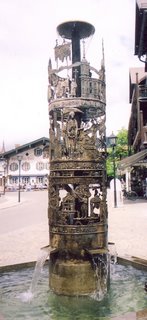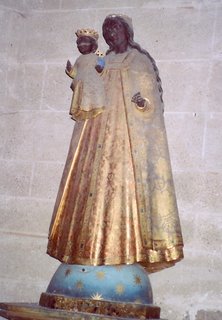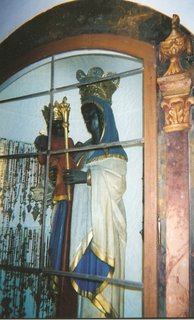 In Eastern and Central Europe, supplications against recurrence of Plague, and gratitude for deliverance, take the form of Marian Columns in many towns, or Plague Columns. In the Czech Republic, there was a particularly virulent epidemic in about 1680, that led to many towns constructing in about 1715 these Plague or Marian, Columns. Here, at Kutna Hora, in the Czech Republic, see Mary at the top with her crown of stars, and the piles of shapes beneath, leading up like so many agonizing buboes, to where she finally rests. See Czech Republic Road Ways. Read about this town in the Czech Republic that lists its Marian Column. //www.zamekvranov.cz/screen.php?str=pamatky_obce_vranov&jazyk=en. Or, see its extreme form - almost ugly in its representation of lump-like pustules, at Olomuc, CZ. Do your own Images search for Olomouc Marian Column.
In Eastern and Central Europe, supplications against recurrence of Plague, and gratitude for deliverance, take the form of Marian Columns in many towns, or Plague Columns. In the Czech Republic, there was a particularly virulent epidemic in about 1680, that led to many towns constructing in about 1715 these Plague or Marian, Columns. Here, at Kutna Hora, in the Czech Republic, see Mary at the top with her crown of stars, and the piles of shapes beneath, leading up like so many agonizing buboes, to where she finally rests. See Czech Republic Road Ways. Read about this town in the Czech Republic that lists its Marian Column. //www.zamekvranov.cz/screen.php?str=pamatky_obce_vranov&jazyk=en. Or, see its extreme form - almost ugly in its representation of lump-like pustules, at Olomuc, CZ. Do your own Images search for Olomouc Marian Column.How did Mary arise to this position, as somehow a safety source from death? No direct answer, but some religious groups give roundabout ones: www.virtualmuseum.ca/Exhibitions/Annodomini/THEME_11/EN/theme11-7. It looks like when it comes down to absolute devastation, a goddess figure works better. Theologians among us?

How humans react to unfathomable disaster. There are many fountains and other kinds of memorials to the era of the Black Death, and how people tried to expiate whatever forces were bringing it on again and again. There were at least three forms of it.
This fountain showing death, disease and suffering from the Plague I believe was in Oberammergau, Germany, or perhaps Garmisch.
A familiar memorial and way to keep the Plague from coming again is the pledge to act a play out in Oberammergau, Germany, every ten years. The next will be in 2010. See www.neuschwanstein-country.net/hotels/Oberammergau/en-oberam. Other sources:
www3.iath.virginia.edu/osheim/intro.
The Plague affected politics, culture, religion, society. See also "The Black Death, Natural and Human Disaster in Medieval Europe" by Robert S. Gottfried, The Free Press, 1983.
One site focuses on the specific outbreak 1347-1350, and focuses on the rat infestation and rats as carriers of the fleas that passed on the Plague, see www.insecta-inspecta.com/fleas/bdeath/.
Climate change - attention, out there - can also be dispositive in how a disease spreads. Other sources say it was not just the rodent infection. That combined with climate change 1050-1347, to extreme cold and wet; then add the movements west of the Huns and others from the East, carrying Plague from where Plague seems to have originated in conditions there, and the carrying of it from port to port. Then, a period of respite, perhaps 8-10 years, maybe more, and it came again. The sick rats died, the survivors began to reproduce again, the infection was still being fostered by the climate and other conditions, and it began again. And again.
Over a hundred years. 1350-1500. Enormous and repetitive depopulation. Overall perhaps a third of the European population died. In each bout, maybe 10% here, 30% there, 50% somewhere else, and then it all began again in differing proportions. And smallpox, measles.
But many modern medicine and religious and literature ideas began with coping with Plague, as did great social and economic change. Bubonic Plague. The Plague. The Black Death.
For more general info, see www.themiddleages.net/plague.
 Black Madonna, Church of St. Mary, Gdansk, Poland
Black Madonna, Church of St. Mary, Gdansk, Poland Black Madonna, Mont St. Michel, France
Black Madonna, Mont St. Michel, France Black Madonna, Altotting, Germany
Black Madonna, Altotting, Germany Black Madonna, Wroclaw, Poland (copy of Jasna Gora?)
Black Madonna, Wroclaw, Poland (copy of Jasna Gora?) Black Madonna, St. Mary's Church, Gdansk, Poland (copy of Jasna Gora)
Black Madonna, St. Mary's Church, Gdansk, Poland (copy of Jasna Gora)